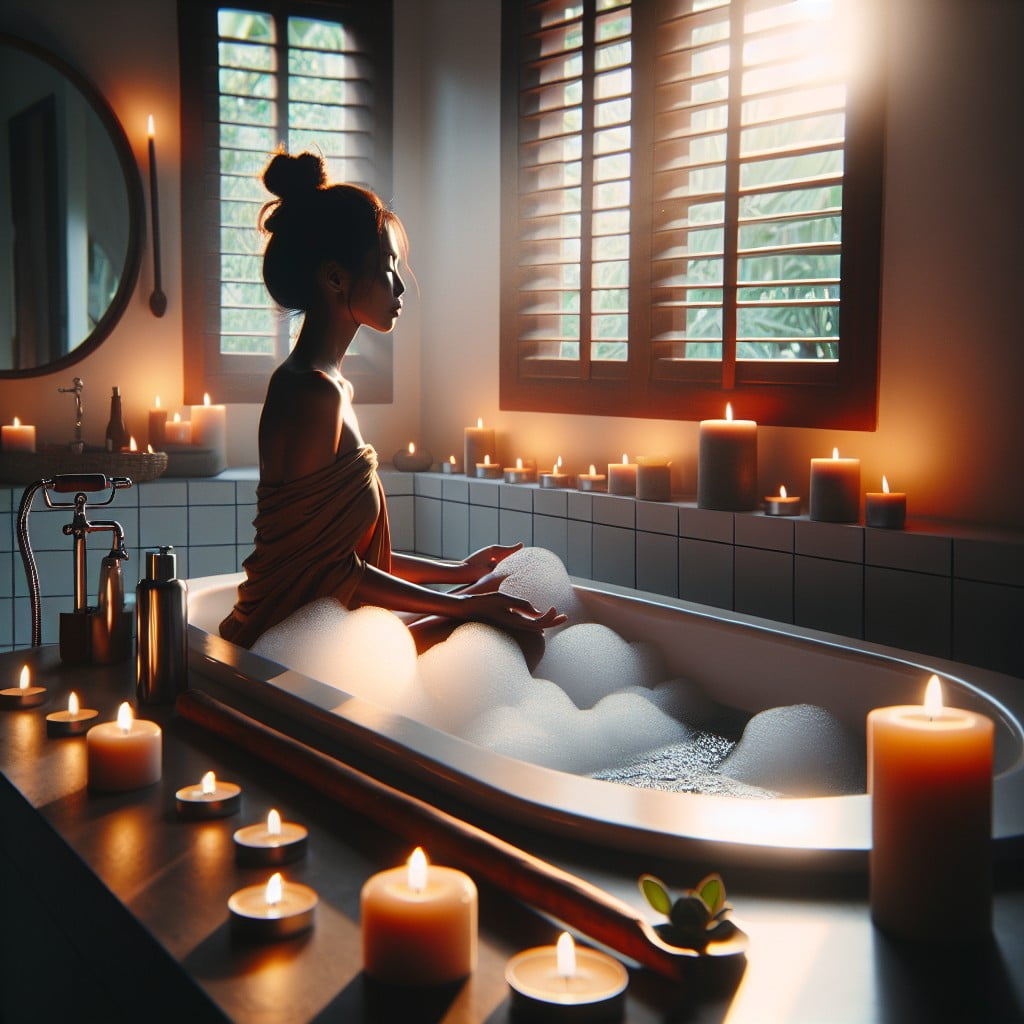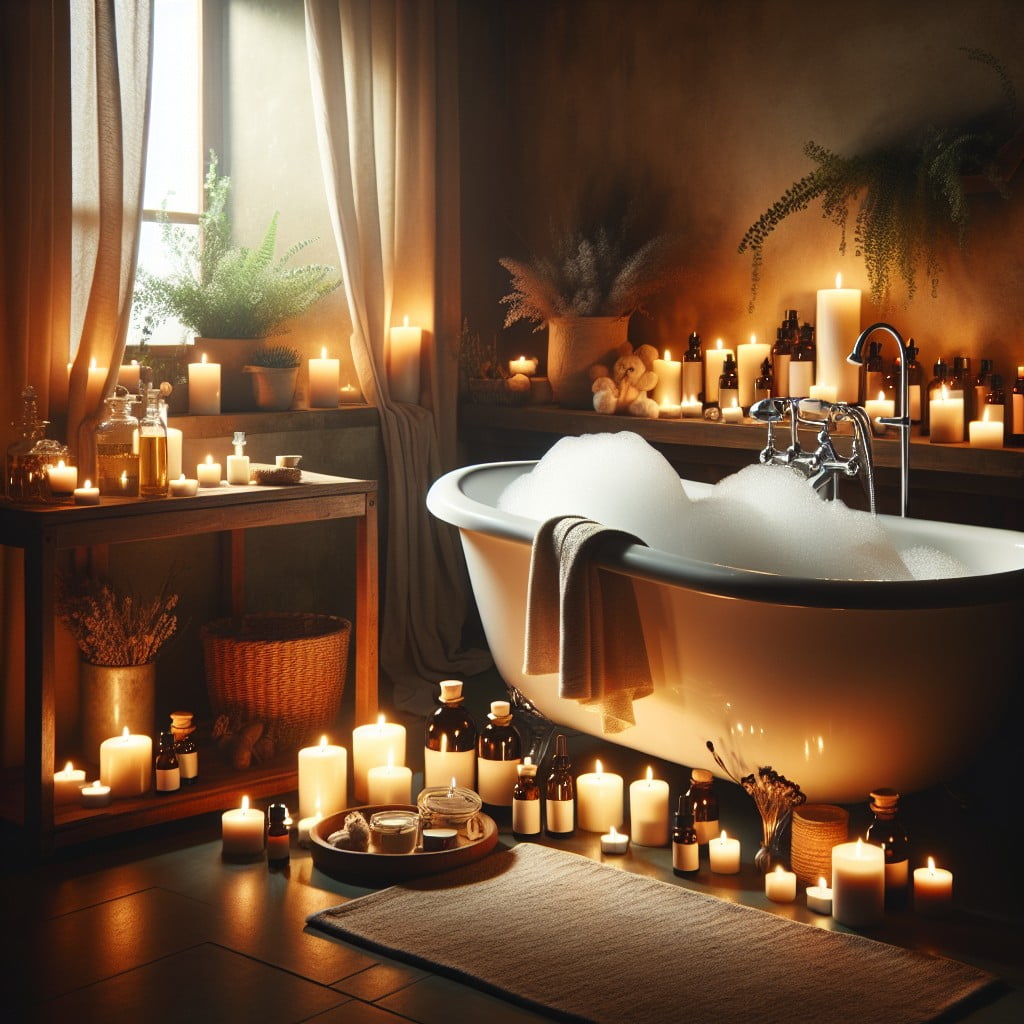Let’s dive into exploring how immersing in a warm bath can enhance your meditation because the delicate balance between water and mindfulness offers a unique, rejuvenating experience.
Yes, you can absolutely meditate in the bath. This practice combines the relaxing properties of a warm bath with the calming benefits of meditation, creating an ideal environment for stress relief and mindful reflection.
As you soak in the tub, you can focus your attention on the sensation of warmth, the movement of water against your skin, or the sound of water filling the tub.
This article will guide you through the process, offering detailed steps and useful tips to help you achieve a deeper state of relaxation and mindfulness during your bath meditation.
Key takeaways:
- Meditating in the bath combines relaxation and mindfulness.
- Control your environment for optimal relaxation.
- Choose relaxing aromas for a calming meditation environment.
- Use aromatherapy bath products for enhanced meditation.
- Breathe deeply and be present in the moment during bath meditation.
Control Your Environment for Bathtub Meditation

Crafting an optimal environment enhances the effectiveness of the bath meditation. Start by eliminating potential distractions; turn off your phone, lock the door, and dim the lights. Warm water is recommended as it relaxes your muscles and promotes a sense of calm. Simple background music or nature sounds can help create a soothing ambience.
1. Mute Potential Disturbances: This could mean silencing your phone to avoid sudden notifications or using ear plugs if there’s external noise.
2. Lighting: Opt for softer lights. Candles can provide the right ambience because their flickering light has a serene, hypnotic effect.
3. Water Temperature: Warm to moderately hot water can help loosen tense muscles, promoting relaxation. However, ensure the water isn’t too hot as it may cause discomfort.
4. Ambient Sounds: Soft instrumental music, nature sounds or peaceful silence can work to calm your mind. Choose what works best for you.
Remember, the more comfortable and at peace you are in your environment, the more successful your bath meditation experience is likely to be.
Steps and Tips for Performing a Bathtub Meditation

Firstly, fill the tub with warm water to a comfortable level and regulate the temperature to your preference. Keep achieving the optimal water temperature as a regular practice for effective meditation.
Secondly, adopt a comfortable position in your bathtub. While some prefer laying flat, others may like sitting with knees bent. Remember, the position doesn’t affect meditation as long as you’re comfortable.
Thirdly, create a quiet ambiance to avoid distractions. Whether you choose to put on soft instrumental music or prefer utter silence entirely depends on you.
Lastly, once settled, close your eyes. Begin to focus your mind inward. Tune into the sensations around you, the warmth of the water, softness of foam, the fragrance of bath salts, or the candle light’s gentle flicker.
It’s important to remember to start slow if you’re a beginner. Start with a few minutes per session and gradually increase the duration over time.
Choose Relaxing Aromas for a Calming Meditation Environment

Selecting the right fragrance goes a long way in setting a serene atmosphere, enhancing your ability to focus, and encouraging relaxation. Here are a few interesting facts to bear in mind:
1. Essential oils have been used for centuries due to their therapeutic value. Consider oils such as lavender, eucalyptus, and chamomile, which can help calm your mind, clear your breathing, and relax your body.
2. The right amount is key. Try a few drops to start with and adjust as per your preference.
3. Use fragrance-free cleaning products before your session. Chemical smells can interfere with the tranquility offered by essential oils.
4. Always do a patch test. Even natural products can cause skin irritation. If you’re using a new product, test it on a small area of skin first.
Remember that an aroma you find calming and pleasant is a perfect choice. Consider experimentating to find what resonates with your sense and boosts your concentration for a peaceful meditation.
Use Aromatherapy Bath Products for Enhanced Meditation

Infusing your bath with carefully selected aromatic essential oils can powerfully enhance your meditation experience. Lavender, for instance, is well known for its calming properties. Its sweet, floral aroma relaxes your mind and allows for deeper meditation. Eucalyptus or peppermint, on the other hand, can help clear the mind and improve focus. It’s best to choose oils that appeal to your senses.
In addition to essential oils, consider products with natural ingredients like Epsom salts or Dead Sea salts. They provide a therapeutic effect, soothing the muscles and nourishing your skin. This further aids in establishing a deep state of relaxation, beneficial for meditation.
Remember, the goal is not just to cleanse your body but also your mind. Engaging your senses with beautiful aromas can transform your bathtub meditation into a profoundly peaceful and restorative experience.
Ensure Physical Comfort During Bathtub Meditation
First and foremost, the water temperature should be just right – warm enough to soothe your muscles but not too hot to make you feel dizzy or overheated. Test the water with your hand before you step in. Once you’re submerged, make sure your body is comfortably positioned. Select a bath pillow or a folded towel for neck support if you don’t have a built-in bathtub rest.
It’s also key to consider the duration of your bath meditation. Overextending your time in water can result in skin irritation and, after a point, no additional relaxation benefits. A 15 to 30-minute session is often enough for most people.
Finally, pay attention to your body throughout the process. If at any point you start feeling uncomfortable, listen to your body and adjust the water temperature, your position, or end the session if necessary. Remember, your bath meditation should be a stress-free and entirely comfortable experience.
Breathe Deeply and Be Present in the Moment During Bath Meditation
A key aspect of bathtub meditation involves focusing on your breath. By paying attention to your inhalations and exhalations, you can cultivate a mindfulness practice that anchors you in the present moment.
1. Long, deep breaths: Slow, deep breaths not only relax the body but also help in reducing stress and anxiety. This also improves your focus, allowing you to concentrate on the sensations of the warm water enveloping your body.
2. Regular rhythm: Try to maintain a regular rhythm in your breathing. This constancy can make it easier to observe subtle shifts in your body and sensations.
3. Observing breath: Simply observe your breath without attempting to control it. This observational standpoint fosters a sense of detachment that cultivates a deeper mindfulness.
4. Body sensation: As you breathe deeply, allow your attention to rest on the sensation of the water against your skin. Notice its warmth, the gentle motion as you move. These sensations bring you further into a state of focused awareness.
Remember, through focusing and engaging deeply with your breath and sensations, you form a bridge between your body and mind, fostering a deepened state of meditation.
Practice Mindful Bathing As a Form of Meditation
Mindful bathing isn’t merely about getting clean; it involves immersing your mind and body deeply within the present moment. This specific practice revolves around focusing attention on the sensation of water against your skin, the warmth surrounding you, and the serenity flowing within the space.
Here are some points to help grasp this unique concept:
- 1. Focusing on Your Senses: Pay attention to the touch of water on your body. The feel of soap, the scent of bath products, and the warmth enveloping you. Use these details to ground yourself in the ‘now’.
- 2. Observing Your Mind: As you sit in the bath, thoughts will float in and out of your mind, akin to bubbles. Recognize them without judgement; then let them go, keeping your attention on your immediate sensory experience.
- 3. Embracing Silence: Allow silence to envelop you. This quietness fosters inner stillness, facilitating you in tuning into your moment-to-moment experience.
- 4. Directing Gratitude: Acknowledge the luxury of having uninterrupted time for self-care. Appreciate the water, the comfort, and the tranquil time.
Through these practical points, the practice of mindful bathing can transition from a luxurious self-care routine to a potent meditation session.
FAQ
Is it possible to meditate in water?
Yes, it is entirely possible to meditate in water, either by sitting or standing, as long as you are relaxed and focused.
Is it better to meditate before or after a bath?
Meditating after a bath is generally more beneficial as it can enhance your focus and stimulate both body and mind for a deeper practice.
How can one establish a mindfulness practice while soaking in the tub?
One can establish a mindfulness practice while soaking in the tub by focusing on the sensations of the warm water, the aromatic scents of the bath, the sound of water, and concentrating on the rhythm of their breathing.
What are the potential benefits of combining bathing and meditation?
Combining bathing and meditation potentially enhances relaxation, improves mood, boosts creativity, and promotes deeper self-awareness.
Can aromatherapy enhance the experience of meditating in the bath?
Yes, aromatherapy can significantly enhance the experience of meditating in the bath by providing calming fragrances that aid in relaxation and mindfulness.